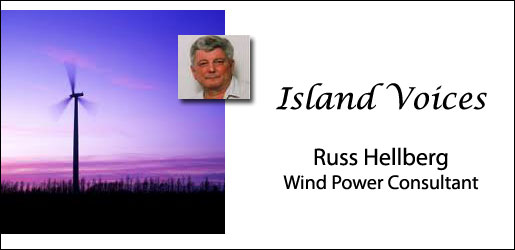Russ Hellberg December 2007
Current Article ∙ Archive ∙ Back to Island Voices
Wind Power is Coming to British Columbia
As part of my series on wind power I am including this article by the Canadian Wind Power Association.
Wind power is determined by more than just how and when the wind blows. Wind energy is the culmination of years of studying the wind and perfecting the technology that harnesses it. Wind is reliable and has the power to make a significant contribution to Canada’s energy needs. In Denmark, 20% of electricity demand is currently met by wind energy. With our abundant resource, there’s no reason why we couldn’t follow their lead – and the Canadian wind energy industry is here to capture that potential.
Changing winds.
Everyone knows that the wind is variable. Sometimes it blows, other times it doesn’t.
So how can wind power be a reliable source of energy? The answer to that lies in how we plan for variability. Most turbines are located in sites where there’s enough wind to produce electricity 70-80% of the time. Naturally, the amount of electricity produced varies with the wind. The way we manage for this variability is to locate wind farms in different geographical areas so that turbines can take advantage of different prevailing winds. The fact is, the wind will never stop blowing everywhere at once – even within a single wind farm, it’s unlikely that all the turbines stop spinning at one time. With Canada’s large and varied wind resource, there’s no doubt that the wind can power us well into the future.
The power of two.
In Canada, we would never rely on wind turbines alone to meet the entire country’s electricity needs. Instead, we use wind in conjunction with other forms of compatible energy production. One example is wind and hydro-electric. These two sources of energy are a natural fit. In the winter, wind is at its peak, allowing hydro to store energy for use when wind productivity is lower. Hydro dams can be closed relatively quickly allowing water reserves to build when peak wind is in full swing. In the spring and fall, hydro is at its peak production and wind energy serves as its supplement. It’s interesting to note how wind energy can help us better manage our precious water resources. As long as there is wind, there will be wind power.
Capturing the energy of wind.
Estimating energy productivity is done through a calculation called capacity factor. If a power plant produced at full capacity 100% of the time, it would have a capacity factor of 100%. Of course, wind is variable, so it doesn’t have a 100% capacity factor but neither does any other form of energy. No energy source, conventional or otherwise, works 100% of the time. It’s simply impossible. There are periods when power plants shut down for maintenance and repairs. There are times when resources run low or when unexpected outages occur. One of the greatest attributes of wind is that it blows hardest – and therefore generates more electricity – in the winter. Wind power offers an opportunity to add more green energy to the grid and to add it during the coldest months of the year, when demand is heavy.
“The variability of wind matches the variability of demand. Generally wind is strongest in cold-weather months when our demand for electricity is highest.”
Wind turbines are reliable.
Wind-generated power is a reliable source of electricity. Wind turbines have one of the highest availability factors – a term that refers to the reliability of the turbines and the percentage of time that a plant is ready to generate energy. Wind has an availability factor of 98% – much higher than conventional forms of energy production.
Maintenance issues are also much smaller on a wind farm. At some conventional power plants, the entire plant may have to be shut down for repairs whereas at a wind farm maintenance takes place one turbine at a time.
Enhanced technology and design improvements have also played a part in increasing the reliability of wind power allowing turbines to generate electricity in all but the most extreme weather conditions. Plus wind forecasting technology has the potential to make wind energy more predictable and more reliable than ever before. Yes, it’s true; the wind blows some of the places all of the time, and all of the places some of the time – but it can’t blow everywhere at once. Wind is variable, but with good site selection, wind farms have access to strong and steady winds.
As of June, 2006, Canada’s installed capacity was 1,049 MW – enough to power about 315,000 Canadian homes.
Source: Canadian Wind Energy Association



![hellberg_clip_image002_0001[1]](http://seniors101.ca/wp-content/uploads/2011/04/hellberg_clip_image002_00011.jpg)